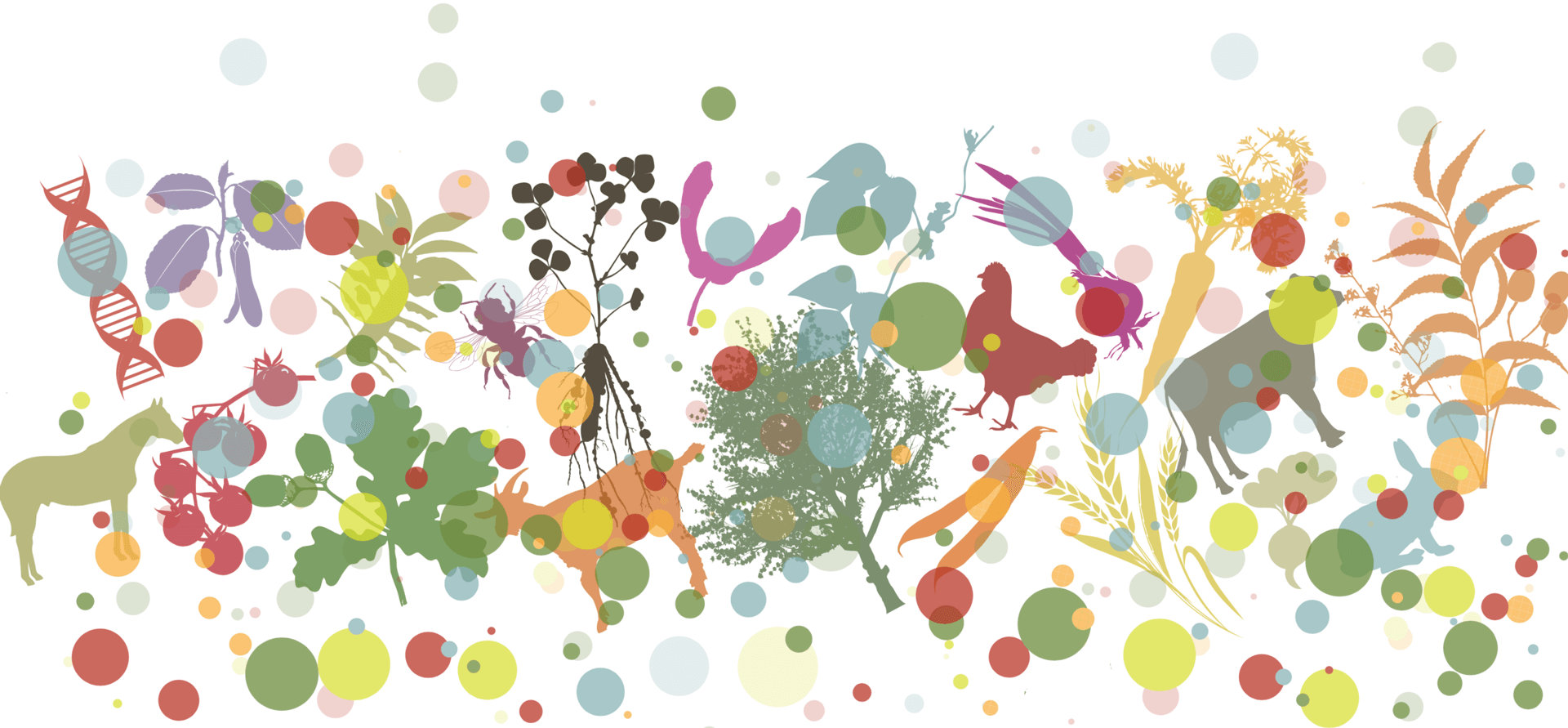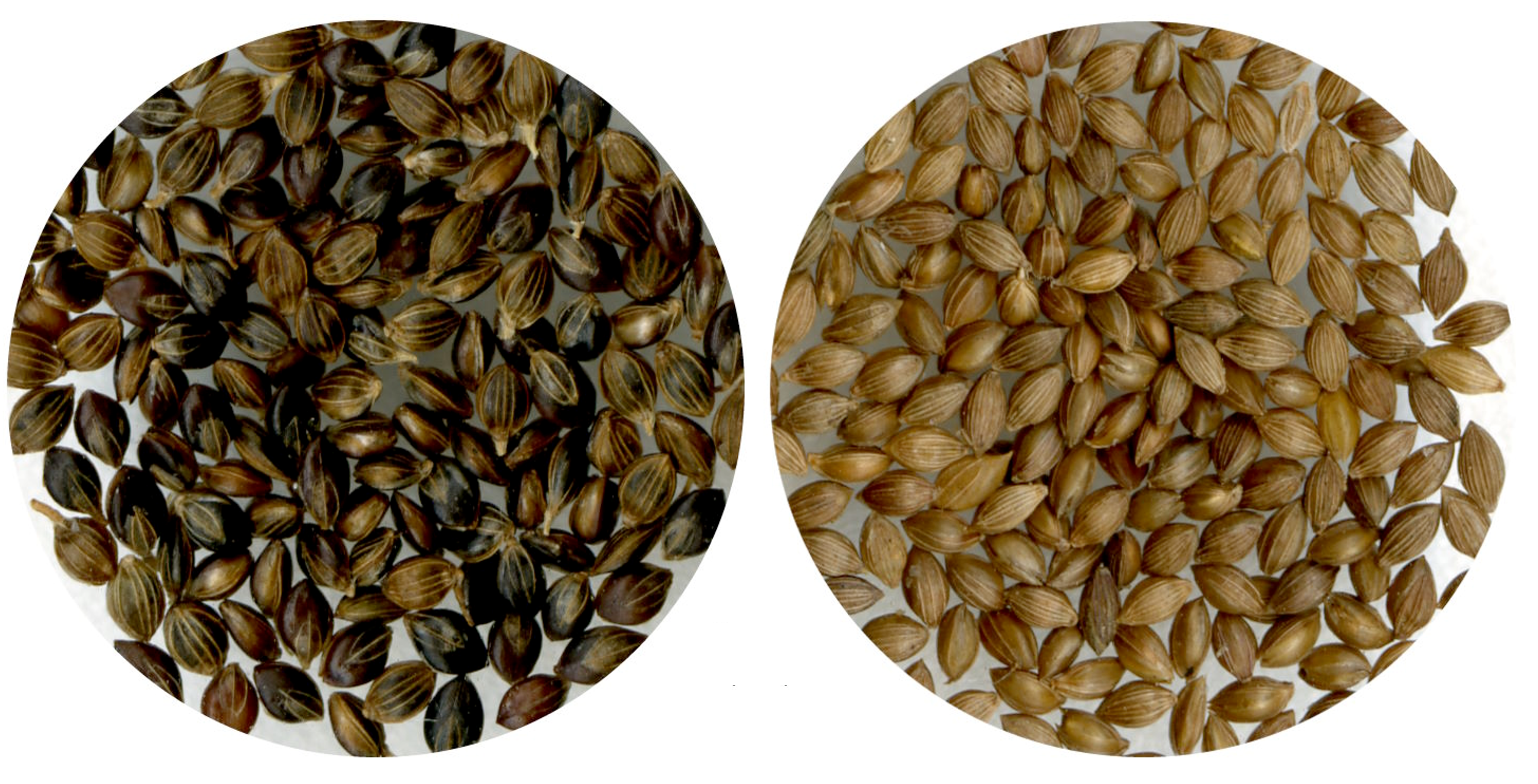A fast and effective method to distinguish cultivated fonio species: conservation and evaluation perspectives
Main Article Content
Abstract
Plant genetic resources characterization is essential for their conservation and their use in both breeding strategies and adaptation to global change. This is all the more important for species often neglected by research such as fonio. Fonio refers to two indigenous small millets grown in West Africa, white and black fonio (Digitaria exilis and Digitaria iburua, respectively). This research was carried out to develop a simple and reliable method to identify the two cultivated species of fonio in the context of genebank collection. A morphometric analysis was performed on seeds of 98 accessions of D. exilis and 20 accessions of D. iburua. Morphometric characters measured were seed dimensions, shape and colour. We showed that the major delimiting criterion was the seed width and that the seeds of black fonio were wider than those of white fonio. The proposed method, based on seed morphometrics, could be applied systematically in conservation routine to guarantee the accuracy of the passport data in fonio collections, as well as to identify fonio remains for archaeological studies.
Article Details

This work is licensed under a Creative Commons Attribution 4.0 International License.
Authors retain copyright of the articles published in Genetic Resources and grant the journal right of first publication with open access. All articles published in Genetic Resource are licensed under Creative Commons Attribution 4.0 International License (CC BY 4.0) that allows others to download, share and adapt the work for commercial and non-commercial purposes as long as proper attribution to the original article is given. Genetic Resources permits and encourages authors to post items submitted to the journal (including the publisher's final layout) on personal websites or institutional repositories after acceptance and/or publication, while providing bibliographic details that credit their publication in Genetic Resources.
Abrouk M., Ahmed H.I., Cubry P., Šimoníková D., Cauet S., Pailles Y., Bettgenhaeuser J., Gapa L., Scarcelli N., Couderc M., Zekraoui L., Kathiresan N., Čížková J., Hřibová E., Doležel J., Arribat S., Bergès H., Wieringa J.J., Gueye M., Kane N.A., Leclerc C., Causse S., Vancoppenolle S., Billot C., Wicker T., Vigouroux Y., Barnaud A., Krattinger S.G. (2020). Fonio millet genome unlocks African orphan crop diversity for agriculture in a changing climate. Nat Commun., 11, 4488. doi: https://doi.org/10.1038/s41467-020-18329-4 DOI: https://doi.org/10.1038/s41467-020-18329-4
Adoukonou-Sagbadja, H., Wagner, C., Dansi, A., Ahlemeyer, J., Daïnou, O., Akpagana, K., Ordon F., Friedt W. (2007). Genetic diversity and population differentiation of traditional fonio millet (Digitaria spp.) landraces from different agro-ecological zones of West Africa. Theor. Appl. Genet., 115, 917-931. doi: https://doi.org/10.1007/s00122-007-0618-x DOI: https://doi.org/10.1007/s00122-007-0618-x
Adoukonou-Sagbadja, A.H. (2010). Genetic Characterization of Traditional Fonio Millets (Digitaria exilis, D. iburua STAPF) Landraces from West-Africa: Implications for Conservation and Breeding. PhD thesis, Justus-Liebig University, Giessen, Germany.
Aliero, A. A. & Morakinyo, J.A. (2002). Characterization of Digitaria exilis (Kipp) StapF and D. iburua Stapf Accessions. Nigerian Journal of Genetics, 16, 10-21. doi: https://doi.org/10.4314/njg.v16i1.42277
Animasaun, D. A., Awujoola, K. F., Oyedeji, S., Morakinyo, J. A., and Krishnamurthy, R. (2018). Diversity level of genomic microsatellite among cultivated genotypes of Digitaria species in Nigeria. African Crop Science Journal, 26(2), 305-313. doi: https://doi.org/10.4314/acsj.v26i2.11 DOI: https://doi.org/10.4314/acsj.v26i2.11
Beck, J., Böller, M., Erhardt, A., Schwanghart, W. (2014). Spatial bias in the GBIF database and its effect on modeling species' geographic distributions. Ecological Informatics, 19, 10-15. doi: https://doi.org/10.1016/j.ecoinf.2013.11.002 DOI: https://doi.org/10.1016/j.ecoinf.2013.11.002
Blench, R. (2016). Finger millet: the contribution of vernacular names towards its prehistory. Archaeol Anthropol Sci 8, 79–88. doi: https://doi.org/10.1007/s12520-012-0103-6 DOI: https://doi.org/10.1007/s12520-012-0103-6
Bonhomme, V., Terral, J.F., Zech-Matterne, V., Ivorra, S., Lacombe, T., Deborde, G., Kuchler, P., Limier, B., Pastor, T., Rollet, P., Bouby, L. (2021) Seed morphology uncovers 1500 years of vine agrobiodiversity before the advent of the Champagne wine. Sci Rep., 11(1):2305. doi: https://doi.org/10.1038/s41598-021-81787-3 DOI: https://doi.org/10.1038/s41598-021-81787-3
Bouby L., Figueiral I., Bouchette A., Rovira N., Ivorra S., Lacombe T., Pastor T., Picq S., Marinval P., Terral J.F. (2013) Bioarchaeological insights into the process of domestication of grapevine (Vitis vinifera L.) during Roman times in Southern France. PLoS One, 8(5): e63195. doi: https://doi.org/10.1371/journal.pone.0063195 DOI: https://doi.org/10.1371/journal.pone.0063195
Chaiphongpachara, T., Changbunjong, T., Sumruayphol, S., Laojun, S., Suwandittakul, N., Kuntawong K. (2022). Geometric morphometrics versus DNA barcoding for the identification of malaria vectors Anopheles dirus and An. baimaii in the Thai-Cambodia border. Sci Rep, 12, 13236. doi: https://doi.org/10.1038/s41598-022-17646-6 DOI: https://doi.org/10.1038/s41598-022-17646-6
Chemisquy, M. A., Prevosti, F. J., and Morrone, O. (2009). Seed morphology in the tribe Chloraeeae (Orchidaceae): combining traditional and geometric morphometrics. Botanical journal of the Linnean Society, 160(2), 171-183. doi: https://doi.org/10.1111/j.1095-8339.2009.00968.x DOI: https://doi.org/10.1111/j.1095-8339.2009.00968.x
Dansi, A., Adoukonou-Sagbadja, H., and Vodouhè, R. (2010). Diversity, conservation and related wild species of Fonio millet (Digitaria spp.) in the northwest of Benin. Genetic Resources and Crop Evolution, 57, 827-839. doi: https://doi.org/10.1007/s10722-009-9522-3 DOI: https://doi.org/10.1007/s10722-009-9522-3
Echendu, C. A., Obizoba, I. C., Anyika, J. U., & Ojimelukwe, P. C. (2009). Changes in chemical composition of treated and untreated hungry rice “Acha” (Digitaria exilis). Pakistan journal of nutrition, 8(11), 1779-1785. doi: https://doi.org/10.3923/pjn.2009.1779.1785. DOI: https://doi.org/10.3923/pjn.2009.1779.1785
FAO. (2010). The Second Report on the State of the World’s Plant Genetic Resources for Food and Agriculture. Rome. url: https://www.fao.org/3/i1500f/I1500F.pdf
FAO. (2020). How the world's food security depends on biodiversity. Rome. url: https://www.fao.org/3/cb0416en/CB0416EN.pdf
Gepts, P. (2006). Plant Genetic Resources Conservation and Utilization: The Accomplishments and Future of a Societal Insurance Policy. Crop Science, 46, 2278-2292. doi : https://doi.org/10.2135/cropsci2006.03.0169gas DOI: https://doi.org/10.2135/cropsci2006.03.0169gas
Goriewa-Duba, K., Duba, A., Wachowska, U., and Wiwart, M. (2018). An evaluation of the variation in the morphometric parameters of grain of six Triticum species with the use of digital image analysis. Agronomy, 8(12), 296. doi: https://doi.org/10.3390/agronomy8120296 DOI: https://doi.org/10.3390/agronomy8120296
Gros-Balthazard, M., Newton, C., Ivorra, S., Pierre, M. H., Pintaud, J. C., and Terral, J. F. (2016). The domestication syndrome in Phoenix dactylifera seeds: toward the identification of wild date palm populations. PloS ONE, 11(3), e0152394. doi: https://doi.org/10.1371/journal.pone.0152394 DOI: https://doi.org/10.1371/journal.pone.0152394
Grosjean, P., Ibanez, F., Etienne, M. (2018). pastecs: Package for Analysis of Space-Time Ecological Series. url: https://github.com/SciViews/pastecs
Guzzon, F., and Ardenghi, N.M.G. (2018). Could taxonomic misnaming threaten the ex situ conservation and the usage of plant genetic resources? Biodiversity and Conservation, 27, 1157-1172. doi: https://doi.org/10.1007/s10531-017-1485-7 DOI: https://doi.org/10.1007/s10531-017-1485-7
Hema, D., and Kannan, D. S. (2019). Interactive color image segmentation using HSV color space. Sci. Technol. J, 7(1), 37-41. doi: https://doi.org/10.22232/stj.2019.07.01.05 DOI: https://doi.org/10.22232/stj.2019.07.01.05
Hunter D., Borelli T., Beltrame D.M.O., Oliveira C.N.S., Coradin L., Wasike V.W., Wasilwa L., Mwai J., Manjella A., Samarasinghe G.W.L., Madhujith T., Nadeeshani H.V.H., Tan A., Ay S.T., Güzelsoy N., Lauridsen N., Gee E., Tartanac F. (2019). The potential of neglected and underutilized species for improving diets and nutrition. Planta, 250, 709-729. doi: https://doi.org/10.1007/s00425-019-03169-4 DOI: https://doi.org/10.1007/s00425-019-03169-4
Idu, M., J. U. Chokor, and O. Timothy. (2008). Effect of Various Hormones on the Germination of Fonio-Digitaria exilis L. International Journal of Botany, doi: https://doi.org/10.3923/ijb.2008.456.460 DOI: https://doi.org/10.3923/ijb.2008.456.460
Ivorra, S., Tengberg, M., Bonhomme, V., Kaczmarek, T., Pastor, T., Terral, J.F., Gros-Balthazard, M. (2024). Leveraging the potential of charred archaeological seeds for reconstructing the history of date palm. Journal of Archaeological Science, 170, 106052. doi: https://doi.org/10.1016/j.jas.2024.106052. DOI: https://doi.org/10.1016/j.jas.2024.106052
Jideani, I.A. (2012). Digitaria exilis (acha/fonio), Digitaria iburua (iburu/fonio) and Eleusine coracana (tamba/finger millet) Non-conventional cereal grains with potentials. Scientific Research and Essays, 7, 3834-3843. doi: https://doi.org/10.5897/SRE12.416
Kaczmarek, T., Cubry, P., Champion, L., Causse, S., Couderc, M., Orjuela, J., ... & Leclerc, C. (2025). Independent domestication and cultivation histories of two West African indigenous fonio millet crops. Nature Communications, 16(1), 4067. doi: https://doi.org/10.1038/s41467-025-59454-2 DOI: https://doi.org/10.1038/s41467-025-59454-2
Karl, K., MacCarthy, D., Porciello, J., Chimwaza,G., Fredenberg, E., Freduah, B.S., Guarin, J., Mendez Leal, E., Kozlowski, N., Narh, S., Sheikh, H., Valdivia, R., Wesley, G., Van Deynze, A., van Zonneveld, M., Yang, M.(2024). Opportunity Crop Profiles for the Vision for Adapted Crops and Soils (VACS) in Africa. doi: https://doi.org/10.7916/7msa-yy32
Koreissi-Dembélé, Y., Fanou-Fogny, N., Hulshof, P. J., and Brouwer, I. D. (2013). Fonio (Digitaria exilis) landraces in Mali: Nutrient and phytate content, genetic diversity and effect of processing. Journal of Food Composition and Analysis, 29(2), 134-143. doi: https://doi.org/10.1016/j.jfca.2012.07.010 DOI: https://doi.org/10.1016/j.jfca.2012.07.010
Khoury, C.K., Bjorkman, A.D., Dempewolf H., Ramirez-Villegas J., Guarino L., Jarvis A., Rieseberg L.H., Struik P.C. (2014). Increasing homogeneity in global food supplies and the implications for food security. Proc Natl Acad Sci U S A, 111 (11), 4001-4006. https://doi.org/10.1073/pnas.1313490111 DOI: https://doi.org/10.1073/pnas.1313490111
Lê, S., Josse, J. and Husson, F. (2008). FactoMineR: An R Package for Multivariate Analysis. Journal of Statistical Software, 25(1). pp. 1-18. doi: https://doi.org/10.18637/jss.v025.i01 DOI: https://doi.org/10.18637/jss.v025.i01
Mondini, L., Noorani, A., and Pagnotta, M. A. (2009). Assessing Plant Genetic Diversity by Molecular Tools. Diversity, 1(1), 19-35. doi: https://doi.org/10.3390/d1010019 DOI: https://doi.org/10.3390/d1010019
Newton, C., Lorre, C., Sauvage, C., Ivorra, S., and Terral, J.-F. (2014). On the origins and spread of Olea europaea L. (olive) domestication: evidence for shape variation of olive stones at Ugarit, Late Bronze Age, Syria - a window on the Mediterranean Basin and on the westward diffusion of olive varieties. Vegetation History and Archaeobotany, 23(5), 567-575. doi: https://doi.org/s00334-013-0412-4 DOI: https://doi.org/10.1007/s00334-013-0412-4
Nyam, D., Kwon-Ndung, E. and Ap, W. (2017). Genetic Affinity and Breeding Potential of Phenologic Traits of Acha (fonio) in Nigeria. Journal of Scientific and Engineering Research, 4(10), 91-101. url: https://irepos.unijos.edu.ng/jspui/handle/123456789/1966
Rami, J.F. (2022). Rigatoni: Object detection (typically grains) in images. R package version 0.9. url: https://github.com/jframi/rigatoni
Rôs, J., Evin, A., Bouby, L., and Ruas, M. P. (2014). Geometric morphometric analysis of grain shape and the identification of two-rowed barley (Hordeum vulgare subsp. distichum L.) in southern France. Journal of Archaeological Science, 41, 568-575. doi: https://doi.org/10.1016/j.jas.2013.09.015 DOI: https://doi.org/10.1016/j.jas.2013.09.015
Schloerke B., Cook D., Larmarange J., Briatte F., Marbach M., Thoen E., Elberg A., Crowley J. (2024). GGally: Extension to 'ggplot2'. R package version 2.2.1. url: https://ggobi.github.io/ggally/
Soladoye, M. O., Sonibare, M. A., and Chukwuma, E. C. (2010). Morphometric Study of the Genus Indigofera Linn. (Leguminosae-Papilionoideae) in South-Western Nigeria. International Journal of Botany, 6: 343-350. doi: https://doi.org/10.3923/ijb.2010.343.350 DOI: https://doi.org/10.3923/ijb.2010.343.350
Stamp, P., Messmer, R. and Walter, A. (2012), Competitive underutilized crops will depend on the state funding of breeding programmes: an opinion on the example of Europe. Plant Breeding, 131: 461-464. doi: https://doi.org/10.1111/j.1439-0523.2012.01990.x DOI: https://doi.org/10.1111/j.1439-0523.2012.01990.x
Terral, J. F., Alonso, N., Capdevila, R. B. I., Chatti, N., Fabre, L., Fiorentino, G., Marinval, P., Pérez-Jordà, G., Pradat, B., Rovira, N., Paul, A. (2004). Historical biogeography of olive domestication (Olea europaea L.) as revealed by geometrical morphometry applied to biological and archaeological material. Journal of Biogeography, 31. 63-77. doi: https://doi.org/10.1046/j.0305-0270.2003.01019.x DOI: https://doi.org/10.1046/j.0305-0270.2003.01019.x
Terral, J.F., Newton, C., Ivorra, S., Gros-Balthazard, M., Morais, C., Picq, S., Tengberg, M., Pintaud, J.C. (2012). Insights into the historical biogeography of the date palm (Phoenix dactylifera L.) using geometric morphometry of modern and ancient seeds. Journal of Biogeography, 39. 929-941. doi: https://doi.org/10.1111/j.1365-2699.2011.02649.x DOI: https://doi.org/10.1111/j.1365-2699.2011.02649.x
Ucchesu, M., Depalmas, A., Sarigu, M., Gardiman, M., Lallai, A., Meggio, F., Usai, A., Bacchetta, G. (2024). Unearthing Grape Heritage: Morphological Relationships between Late Bronze–Iron Age Grape Pips and Modern Cultivars. Plants, 13(13): 1836. doi: https://doi.org/10.3390/plants13131836 DOI: https://doi.org/10.3390/plants13131836
Ulian, T., Diazgranados M., Pironon S. et al (2020). Unlocking plant resources to support food security and promote sustainable agriculture. Plants, People, Planet, 2: 421-445. doi: https://doi.org/10.1002/ppp3.10145 DOI: https://doi.org/10.1002/ppp3.10145
Weise, S., Lohwasser, U., Oppermann, M. (2020). Document or Lose It - On the Importance of Information Management for Genetic Resources Conservation in Genebanks. Plants 2020, 9, 1050. doi: https://doi.org/10.3390/plants9081050 DOI: https://doi.org/10.3390/plants9081050
Zeileis, A., Fisher, J. C., Hornik, K., Ihaka, R., McWhite, C. D., Murrell, P., Stauffer, R., and Wilke, C. O. (2020). colorspace: A Toolbox for Manipulating and Assessing Colors and Palettes. Journal of Statistical Software, 96(1), 1-49. doi: https://doi.org/10.18637/jss.v096.i01 DOI: https://doi.org/10.18637/jss.v096.i01







 This journal has been conceived as part of the
This journal has been conceived as part of the